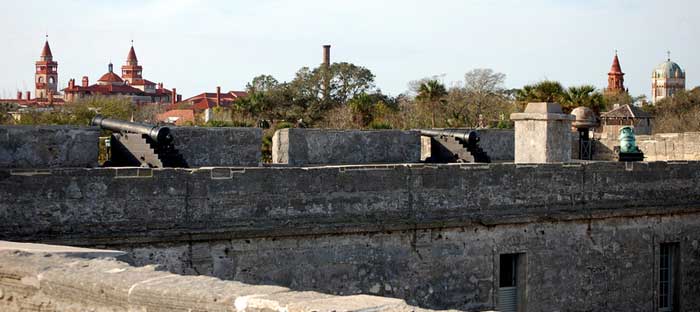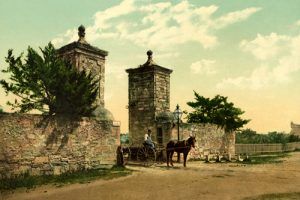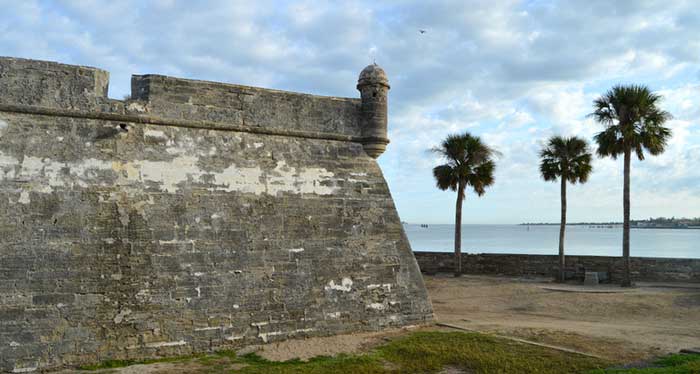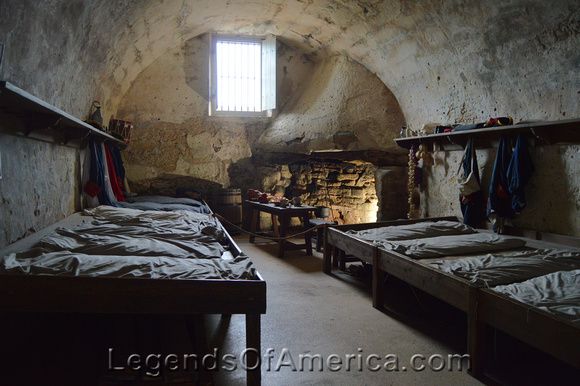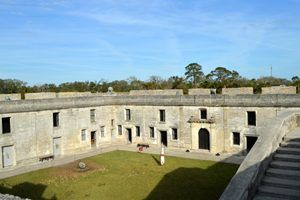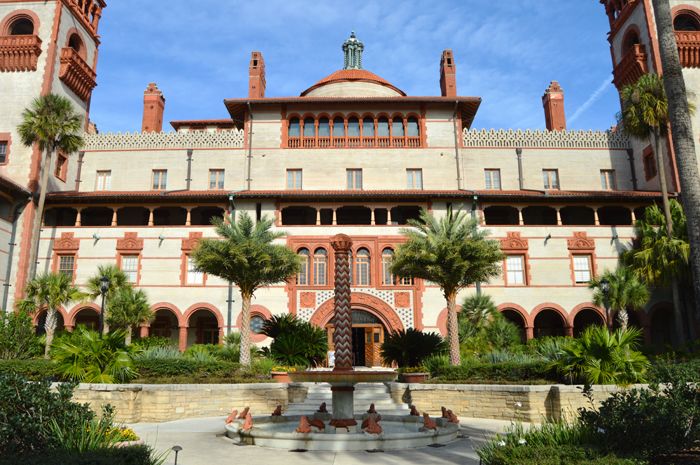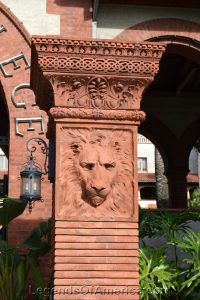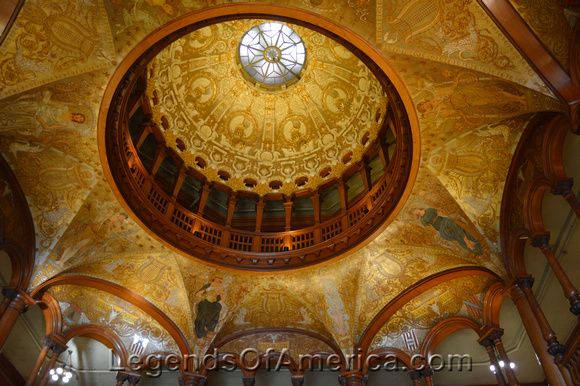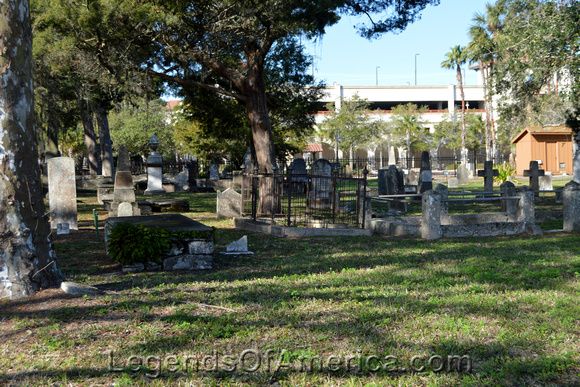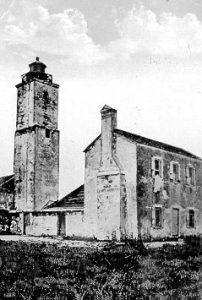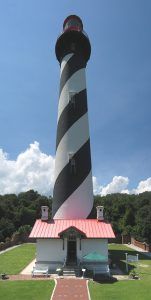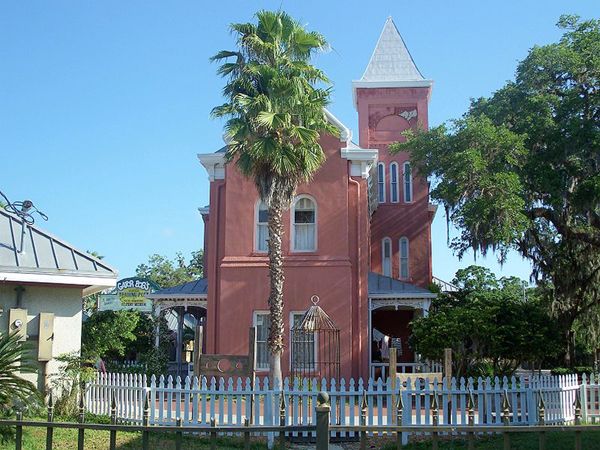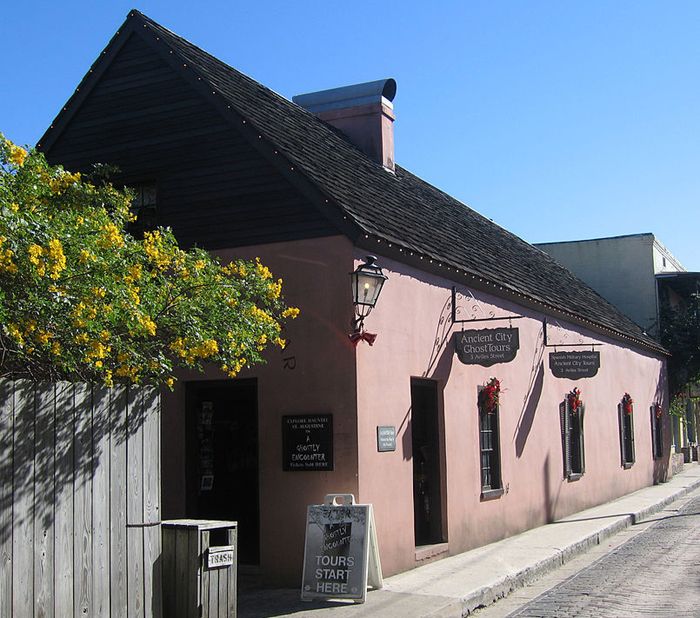Located in Northeast Florida, St. Augustine is the oldest continuously occupied European-established settlement and port in the continental United States. It is appropriately called the “Nation’s Oldest City”, and to many of the locals, it is known as the “Ancient City”. After more than 450 years, it is also said to be one of the most haunted cities in America.
Haunted Places:
Casablanca Inn
Built in 1914, this Mediterranean Revival style two-story inn was first called the Matanzas Hotel. It changed hands in about 1920 and the new owner — a widow — changed the name to the Bayfront Boarding House. Taking great pride in running a clean and comfortable boarding house that offered excellent meals, the establishment was soon very busy and reservations began to be required in order to secure a room. After a few years, she changed the name to the Casablanca Inn.
These were the years of Prohibition and bootleggers were very active in bringing alcohol into St. Augustine from Cuba. Legend has it that the widow began to have a relationship with one of the bootleggers and she was in an excellent position to provide assistance. Though her clientele was a broad range of salesmen, families, and other travelers, during this time, she also hosted a number of FBI agents who were in town to enforce the law. Soon, she began to assist the rumrunners. When no agents were in the city, she would swing a lantern at night from the top of her inn, signaling that it was safe to deliver the alcohol. She also made arrangements to have booze to provide her customers who wanted to drink. The smugglers paid her handsomely for her help.
At one point, she was allegedly questioned by an agent, but the suspicion was dismissed. By the time Prohibition ended in 1933, she had made enough money to live well for the rest of her life. When she died she was buried in the Huguenot Cemetery. However, many who have visited the inn, report that though she may have died, she never left.
Claims have been made that many people in boats have seen a lantern swinging atop the hotel at dusk. Others have stated that they saw a dark figure swinging the lantern. Staff and guests have reported seeing a misty fog like female apparition at various places inside and outside the inn. Others have felt a gentle touch, the sounds of footsteps when no one is near, disembodied voices, and the strong scent of oranges, which were associated with her.
Though she is said to be a kindly ghost, a number of prankish activities have been reported such beds becoming unmade, televisions and lamps that turn on and off by themselves, even when unplugged, items being moved around and tablecloths removed from tables. On one occasion, a night innkeeper heard loud footsteps and doors opening and closing on the floor over him, but that section was unoccupied.
Restored to its former glory today, the Casablanca Inn serves as a beautiful bed and breakfast inn today.
The oldest existing permanent seacoast fortification in the continental United States, Castillo de San Marcos, in St. Augustine, Florida was built between 1672 – 1756.
Though the Spanish founded St. Augustine in 1565, it would be another hundred years before they began building the Castillo de San Marcos. The earlier wooden forts did not last long. Some of them burned down, some were washed away by storms, and some just rotted from neglect.
However, two events took place around the mid-1600s that made the Spanish realize that it was time to build a stronger fort to defend their town and their colony of La Florida.
The first event was in 1768 when the pirate Robert Searles attacked St. Augustine. Unlike Sir Francis Drake, who had attacked and burned St. Augustine to the ground a hundred years earlier, Searles did not burn the town or destroy the wooden fort. However, the Spanish feared he might return with more men and turn St. Augustine into a pirate camp to attack Spanish treasure ships. They needed more protection.
The second event was the founding of South Carolina by the English in 1670. The English had settled Jamestown, Virginia 42 years after the Spanish founded St. Augustine, followed by the Pilgrim’s settlement at Plymouth, Massachusetts in 1620. But, these colonies were too far away to be a threat. Even the establishment of Maryland and New York over the next decades did not much affect the Spanish. However, that changed in 1670 with the establishment of South Carolina. The English were now much too close for comfort and the Spanish Crown sent money to St. Augustine for the building of a stone fortress.
After more than three centuries this magnificent fort continues to stand and today is not only a destination for tourists but also is apparently called home to a number of restless spirits. The largest masonry structure of its kind in the nation, this 17th century fortress has survived years of battles and storms, changed ownership five times (Spain, Britton, America, Confederate States of America, then back to US control again), pirate attacks, and served as a prison throughout the years, witnessing the deaths of many. The fortress has also been a silent spectator to a number of gruesome stories. It is no wonder that it is haunted.
During the many years it took to build the fort, a number of workers died due to hard labor, tropical heat and diseases. During this time of Spanish control, it is believed that a hidden room in the lower chambers was used as a torture chamber during the brutal Spanish Inquisition. It wouldn’t be until years later that the room was discovered when a heavy American cannon fell through the floor revealing a room containing ashes and human bones.
In 1702, when Spain was at war with Great Britain, the British launched a major attack on St. Augustine. For 50 days, the British besieged the fort, captured hundred of Indians for slaves, and burned the hospitals, monasteries, and the valuable Franciscan library. In the end, the Castillo de San Marcos was the only structure to survive in St. Augustine. Dozens of men on both sides of the conflict were killed.
In 1784, the fortress was under the command of a Spanish officer named Garcia Marti. Colonel Marti was married to a woman named Dolores, who was renowned for wearing a distinctive perfume which she used liberally. Marti was a busy man and began to suspect that his younger beautiful wife was having a clandestine relationship with one of his subordinate officers. His suspicions were confirmed when his young and handsome assistant — Captain Manuel Abela — reported for duty smelling of his wife’s distinctive perfume. Suddenly both Dolores and Captain Abela went missing. It was explained that Abela had been sent on a special mission to Cuba and that Dolores had become ill and had been sent to live with her Aunt in Mexico. Though rumors abounded, Colonel Marti wasn’t directly challenged.
It would be nearly five decades before the truth would be discovered. In 1833, the Castillo de San Marcos was under American control when an American officer discovered a hollow sound in one of the walls of the dungeon area. Puzzled, he removed a brick and outflowed the smell of a strong perfume. Soon, an entire hidden room was discovered, within which were two skeletons chained to the wall. It is believed that the couple was chained to the wall and left there to die a slow death.
Today, it is said that a female apparition, thought to be the forlorn spirit of Delores Marti, roams the grounds of the Castillo wearing a white dress. Other reports say that the screams of the slowly dying couple can be heard through the stone wall of the room where they were held when visitors place their ear against it.
The dungeons below the Castillo have kept numerous prisoners including that of Chief Osceola in 1837 during the Second Seminole War. Other captives over the years included more than 500 Apache prisoners who were followers of Geronimo, which included women and children; pirates, and prisoners of war. Though a few escaped, others were released, there was no doubt, many who met their deaths while being held in cramped, dank conditions in the dungeon.
Reports of paranormal activity at the Castillo include sightings of Spanish soldiers patrolling the grounds, the ghost of a Seminole Indian who seemingly leaps to freedom from the high fortress walls, a Spanish soldier who is often spied at sunrise and sunset standing at the edge of the fort looking out to sea. In the 18th century, a Spanish soldier was killed by a cannonball while searching for a ring on the grounds. His spirit is said to be seen still looking for the ring.
Other paranormal activity includes a light that shines from a watchtower on stormy nights even though the tower has no electricity. In the dungeon, visitors report a number of sensations including felling as if someone with cold hands had touched them, unexplained noises, and people talking. Many report having felt goosebumps and feeling ill while walking through. Photos taken at the fort often display misty shapes, strange lights, and what appears to be translucent ghosts.
In other places within the fort, flashes of light have been seen coming from the brass cannons, wisps of smoke, more spirits dressed in soldier’s uniforms, and the sounds of screams.
Flagler College-Hotel Ponce de León
In 1882, Henry Flagler, a New York entrepreneur and co-founder of Standard Oil, became interested in the historic city of St. Augustine and its potential as a winter resort. Flagler’s subsequent development of transportation and resort facilities in St. Augustine and along the east coast of Florida spurred rapid development in the late 19th and early 20th centuries. A focal point of this development was Flagler’s Hotel Ponce de León. In 1887 Flagler hired two young architects from the prominent New York firm, McKim, Mead, and White, to design the hotel. With the design of the Ponce de Leon, John Carrere and Thomas Hastings launched a new architectural firm, Carrere & Hastings, which would gain national prominence. Flagler chose the Spanish Renaissance Revival style so that the hotel’s design would complement its historic surroundings. Retained to decorate the interior of the hotel, Louis C. Tiffany used stained glass, mosaics and terra cotta relief on the walls and ceilings and commissioned several grand murals. The hotel was the first large scale building constructed entirely of poured concrete.
The popularity of “the Ponce” and its style strongly influenced the architecture of southern Florida for the next 50 years. The success of the Hotel Ponce de Leon was episodic, immediately contending with a yellow fever epidemic and the worst freeze in state history in 1895. St. Augustine’s weather proved not to be as warm and sunny as other resort areas that were developed further south along the peninsula, and the town never boomed as a winter resort. However, tourists did come during the first decades of the 20th century, and the Ponce de Leon was one of only three Flagler Hotels to survive the Great Depression. Following a lull in tourism during World War II, the hotel attracted large crowds for several years. Some of its famous guests included Ernest Hemingway, Mark Twain, Babe Ruth, Martin Luther King, Jr., and Presidents Theodore Roosevelt and Lyndon Johnson. Unfortunately; however, over the years, the hotel declined and in 1967 the hotel closed and was sold to Flagler College. It has been renovated and today and retains most of its original integrity. It was added to the U.S. National Register of Historic Places in 1975 and became a U.S. National Historic Landmark on February 21, 2006.
Today this historical landmark is said to remain home to a number of unearthly residents including Henry Flagler himself. When the wealthy entrepreneur died in 1913, he was laid in state in the hotel’s rotunda. When his casket was being carried out, all the doors suddenly slammed, and legend has it that his spirit was trapped in the rotunda. Reports are that Flager continues to keep an eye on his hotel.
Another spirit is said to be that of Henry’s second wife, Ida Alicia Shourds. Ida, who was the nurse for the first Mrs. Flagler. She was described as frivolous and high-strung when Henry Flagler married her two years after his first wife’s death. But, as time passed, it began to appear that she suffered from mental illness – potentially manic-depressive or bipolar disorder. She began to dabble with a Ouija board and became involved in a spiritualist movement that was popular in St. Augustine at the time. As she talked with the dead, read tarot cards, and attended spiritual meetings, her behavior became more and more erratic — so much so that she was forced to spend some time in a mental hospital.
However, she was soon released, returning immediately to her Ouija board sessions again. Before long, she was sent back to see a psychiatrist, at which time she attempted to kill the doctor by stabbing him with a pair of scissors. In March 1899 she was legally declared insane. A year and a half later, Henry Flagler divorced Ida and quickly remarried a third wife.
Today, Ida Alice is said to haunt the East Wing women’s dorm, walking the halls of the top floor, and at one point taking up residence in a dorm room occupied by a girl who looked much like her. Though not harmful, the girl eventually transferred to another college.
A third lost soul is said to be that a former mistress of Henry Flagler. Called the “Woman in Black”, the story says that Flagler had an on-going extra-marital affair with a young woman while he was married to Ida Alicia. Henry was said to have kept his mistress, who was always dressed in black, in a suite of rooms in the hotel and forbade her to leave the rooms whenever Ida stayed at the hotel. Legend has it that the young woman eventually became so depressed that she hanged herself.
Other restless spirits are also said to continue to reside at the hotel including a young boy who fell to his death in the hotel. A number of people have reported a little boy who tugs at them and asks to play. Others have reported seeing a ball bouncing or rolling down the hallways.
Yet, another mistress is said to haunt the hotel, though this one wasn’t Flagler’s. The story tells of a woman who, while a guest at the hotel, had an affair with a married man which resulted in a pregnancy. Of course, she wanted the man to divorce his wife and marry her. This led to a meeting between the man, his wife, and his mistress at the hotel. Obviously, the meeting didn’t go well for the mistress, as she is said to have emotionally run away from the meeting, fleeing up the stairs to her room. However, along the way, she tripped and fell down the stairs to her death. Called the “Lady in Blue”, this spirit is said to be the one who is most frequently appears, seen and heard crying in the hallways or the dining room.
In addition to sightings of the spirits, other paranormal activity has been reported including the sound of footsteps and voices when no one is present and objects that mysteriously get moved about.
Huguenot Cemetery
Located just across from the Old City Gate, the Huguenot Cemetery was a Protestant burial ground between the years 1821 and 1884. When the Americans took possession of St. Augustine and Florida Territory, the only burial ground within the city, the Tolomato Cemetery, was reserved for Catholics. Recognizing the need for a Protestant cemetery, an area just outside the city gate was chosen by the new American officials. The cemetery was established just prior to a yellow fever epidemic which claimed the lives of a large number of the city’s residents. Burials continued until 1884 when both Huguenot and Tolomato cemeteries were closed. The cemetery is believed to hold the remains of about 436 people.
Today, the old burial ground is said to be the most haunted cemetery in St. Augustine, so much so that it is often referred to as “Spirit Central”.
One of the most often seen spirits is that of Judge John Stickney. From New York, the judge fought in the Civil War and afterward moved with his three children to St. Augustine. His wife had already passed away. He first worked as a lawyer and was then appointed as a States Attorney for the 6th Judicial Circuit of Florida. He was also a U. S. Commissioner for the Northern District of Florida and Justice of the Peace. He soon became well-known and much liked within the community as he was often known to offer free legal advice. Unfortunately, he contracted yellow fever and died in 1882. He was laid to rest at the popular Huguenot Cemetery and his children moved back north. Some years later, they wished their father’s remains to moved to Washington DC to be re-interred. Gravediggers were hired to do the work, but when they took a short break, they returned to find the grave being robbed. The thieves immediately ran, but they had already made off with some valuables including the Judge’s gold teeth. Today, though his remains are gone, the Judge is said to haunt the graveyard. He is sometimes seen walking the grounds both day and night as if looking for something. Other times he has been spied sitting in a tree.
Another restless spirit that has been seen in the cemetery is a young girl, said to be around 14 years old. She, too, died of yellow fever and her body unceremoniously dumped at the Old City Gates. When no one claimed the body, she was buried in the Huguenot Cemetery. Obviously, she isn’t resting peacefully as numerous people have seen her spirit floating in the trees, Described as wearing a flowing white gown, she often waves at visitors.
Other reports from visitors tell of seeing strange mists and unexplained flashes of light, the sounds of a man laughing, and the crackling of leaves while in the ancient graveyard. Many also describe photos they’ve taken to include strange phenomena such as orbs and misty areas.
The Lighthouse
Standing at the north end of Anastasia Island in St. Augustine, Florida, the St. Augustine Light Station is an active lighthouse built in 1874. However, a Spanish watchtower was built on this same site in the late 1500s. Over the years, a series of wooden watchtowers evolved into Florida’s first lighthouse, which was built on the site in May 1824 by Florida’s American territorial government.
The first lightkeeper was a man named Juan Andreu, who was the first Hispanic-American to serve in the Coast Guard and the first to oversee a federal installation of any kind. He continued to serve until 1845. Nine years later, his son, Joseph would take up the same position in 1854. Unfortunately, Juan was killed in an accident when he fell 60 feet to his death when the scaffolding gave way while he was whitewashing the tower in 1859. Joseph’s wife, Maria Mestre de los Dolores Andreu, took over as keeper, becoming the first woman to serve as an official lighthouse keeper in Florida and the first Hispanic-American woman to lead a federal shore installation. She served as keeper of the St. Augustine lighthouse for three years. In 1862, with the Civil War underway, the light was extinguished, fearing it would aid the Union Navy. Paul Arnau, collector of customs in Saint Augustine, removed and buried the lens. It was eventually recovered, but the light was not relit until 1867.
By 1870, the shoreline erosion was threatening the lighthouse and Congress appropriated $100,000 to build a new one. Construction began in 1871 and continued for three years until the beacon was lit in October 1874. The original Fresnel lens remains today as one of only a few such operating lenses in the United States. In the meantime, a jetty of coquina and brush was built to protect the old tower. However, it wasn’t enough as the 1824 lighthouse was destroyed during a storm in 1880.
On August 31, 1886, the Charleston earthquake caused the tower to “sway violently”, according to the keeper’s log, but there was no recorded damage. In 1907, the lighthouse received modern plumbing and in 1925, it received electricity in the keeper’s quarters. The tower light was electrified in 1936. During World War II, Coast Guard men and women trained in St. Augustine, and used the lighthouse as a lookout post for enemy ships and submarines which frequented the coastline.
The U.S. Lighthouse was incorporated into the U.S. Coast Guard in 1939.
In 1955, the light was automated and the positions for three lighthouse keepers slowly dwindled down to two and then one. No longer housing lighthouse families by the 1960s, the keepers’ house was rented to local residents. Eventually, it was declared surplus and suffered a devastating fire at the hands of an unknown arsonist in 1970.
In 1980, the Junior Service League of St. Augustine, which included 16 volunteers began a 15-year campaign to restore the Keepers’ House that was destroyed in the fire. The League then began to restore the lighthouse tower with the assistance of the United States Coast Guard. A maritime museum was opened to the public part-time in 1988 and in the Spring of 1994, the full site was opened to the public full time.
Today, the Lighthouse is St. Augustine’s oldest surviving brick structure and has been restored to the colors and materials used the year 1888. The lighthouse rises 165 feet above sea level. At the top, the original, first-order Fresnel lens still serves the beacon, but today is lit by a 1000 watt bulb, and maintained by the museum and volunteers. The grounds also consist of the 1876 Keepers’ House, two summer kitchens added in 1886, a 1941 U.S. Coast Guard barracks and a 1936 garage that was home to a jeep repair facility during World War II.
There are numerous reports of spirits who continue to reside on the grounds of the old lighthouse, some of whom are believed to be previous lightkeepers and their families. During its long history, several tragic events have occurred that many feel attribute to the unusually high level of paranormal energy.
One of the first was the unfortunate accident of Juan Andreu who is said to continue to look after his beloved lighthouse. An apparition caught on film by the Ghost Hunters show is believed to be the old lightkeeper. He is often spied moving on the top level of the stairs inside the lighthouse as well as staring through the window.
Another accident occurred on the grounds when three young girls were playing with a handcart near the ocean. When the cart broke they fell into the sea and drowned. Today, there are a number of tales about the girls seen roaming the ground, visitors who hear the voices of children playing, apparitions of the girls sometimes seen swinging on the swing set, laughter, faces seen peering from the windows, and the spirit in a blue dress floating above the grounds.
Though no tragic accident is known to have occurred to a former lightkeeper, Peter Rasmussen, he is also said to keep a watchful eye on the property, leaving behind a strong odor of cigar smoke.
Throughout the history of the lighthouse, San Augustine has often been the site of violence, disease, and murderous storms. Perhaps some of the paranormal energy comes from others who are unknown to the property. Further events include random unexplained noises, objects that have been moved and thrown, a woman’s voice that is sometimes heard, laughter heard from the top of the tower, locked doors that are mysteriously found open, music boxes that turn on by themselves, and cold spots and drafts.
The Old Jail
The Old Jail building was built in 1891 and financed by Henry Flagler, owner of the Ponce de Leon Hotel. The former jail building stood on land that Flagler needed for the construction of his hotel and he wanted to ensure a safe and pleasant environment for his customers by creating a secure building to house criminals. He also wanted the building to be farther from the hotel and to blend beautifully into the neighborhood. To accomplish this, the building was designed with a Romanesque Revival style that gave it the distinct appearance of a Victorian home, so much so that it was almost unrecognizable as a jail apart from the barred windows.
Originally built to house up to 72 prisoners, the two-story northern wing of the jail was a general population and maximum security area, a women’s section and a lower level kitchen. Maximum Security housed the most dangerous prisoners and included a Death Row cell. Eight men were hung from the gallows on the jail compound during its history. The two-story southern wing of the Jail consisted of an Office for the Sheriff and living quarters for his family.
During its more than six decades, life inside the jail was in vast contrast with the beauty of its exterior. Conditions for the prisoners were said to have been very poor with meager rations, infrequent bathing toilet facilities that consisted of one bucket per cell and hard labor during the day as prisoners were sent to work in neighborhood farms. Disease, violence, and death were said to be commonplace.
The jail served as the St Johns County Jail until 1953 and just one year later, became a local attraction. In 1987 it was listed on the U. S. National Register of Historic Places. Today, the Old Jail Museum provides guests to St. Augustine with a glimpse into the history of the penal system and the daily life of its prisoners. The guided tour includes the restored jail and sheriff’s living quarters, a display of weapons and artifacts, a pictorial history of the executions, and more.
Today, it is said to be haunted by former inmates and a former warden, Sheriff C.J. Perry. Perry lived with his family in the residential quarters and was known to have been strict and harsh in his punishments. Strange sounds are often reported including chains rustling, the gallows dropping, and dogs barking and whining. Apparitions have been sighted in the form of both inmates and the sheriff.
The Old Jail Museum is located at 167 San Marco Avenue, just north of the downtown district.
Spanish Military Hospital
The Spanish Military Hospital Museum is an authentic reconstruction of a military hospital that stood on this site during the Second Spanish Colonial Period (1784–1821). The three-part facility consisted of a west wing constructed in the first Spanish period, an east wing constructed during the British Period and the Apothecary in the William Watson House, which was also constructed in the British Period.
Strictly a military facility, the three parts plus their outbuildings and gardens functioned as a hospital complex during the Second Spanish Period.
In 1818 the west wing burned but the remaining parts stayed in operation. In 1821 the city needed to replace water lines that ran under the building, at which time they discovered thousands of human bones buried underneath the hospital. The hospital remained operational until two years into the American Territorial Period, officially closing in 1823. The east wing was destroyed in a fire in 1895. Only the original Watson house still stands today. Over the years, several buildings were built over the land where the hospital wings once sat. Potter’s Wax Museum is located on the lot where Hospital West was located. The last building over Hospital East was demolished in the early 1960s. Archaeological digs at that time uncovered the original foundations of the hospital building. Using those foundations and the Spanish records of the hospital, the building was reconstructed.
Today the reconstructed east wing of the old hospital is a museum that recreates the hospital practices of the late 1700s. They include a full surgical demonstration of procedures done at the time, an apothecary demonstration discussing the medicines used and their manufacture, and a tour of the medicinal herb gardens.
With the many deaths that have occurred at the old hospital, it comes as no surprise that some of the spirits of those who passed remain today. Paranormal reports tell of hearing cries, moans, and screams as well as ghostly apparitions seen in hospital gowns, with some of the missing limbs,
The St. Francis Inn
Dating back to 1791 during the city’s Second Spanish Colonial Period, this building is St. Augustine’s “oldest inn” and is listed on the National Register of Historic Places. Gaspar Garcia, the property’s first owner, was a military man who was granted the lot in by the King of Spain, and shortly thereafter built a home. At that time, the threat of invasion was so great that the King of Spain ordered that all houses were to be constructed so that they might “serve as a defense of fortress against those who might attempt to occupy the town.”
In 1838, it was bought by Thomas Dummett and six years later, after his death, it was turned into a boarding house by his daughter, Anna Dummett in 1845. From that time forward, the building has served continuously as a lodging house. The name was officially changed to the St. Francis Inn in 1948. Fully restored today, it continues to cater to St. Augustine visitors.
It is also said to be haunted by what is believed to be several former tenants. Paranormal activity includes sightings of misty spirits, objects being moved and thrown, and some visitors reporting being touched by an unseen apparition.
Updated October 2019
Also See:
Most Haunted Places in the United States
St. Augustine – Oldest U.S. City
Sources:
Four Girls and a Ghost
Ghost Hearse
Ghosts and Gravestones
Haunted Houses
Haunted Places To Go
Lighthouse Friends
Miami Paranormal
National Park Service
St Augustine Ghosts
St. Augustine Lighthouse
St. Francis Inn
Travel Channel
Visit St. Augustine
Wikipedia

